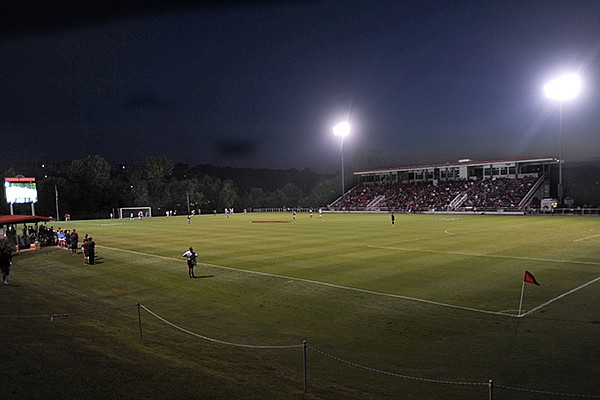FAYETTEVILLE — When Arkansas begins work to expand Donald W. Reynolds Razorback Stadium next month, it will be the university's eighth athletics construction or renovation since 2011 when athletics director Jeff Long laid out a 30-year facilities master plan.
The stadium renovation is scheduled to begin just after the Razorbacks' final home football game against LSU. It will begin with the demolition of the Broyles Athletic Center and the video scoreboard on the north end of the stadium. Both will be rebuilt along with the construction of new suites, boxes and club seats that will expand the stadium's capacity to about 77,000.
The project's $160 million price tag is larger than all of Arkansas' previous seven projects combined.
When construction begins there, the question begs: What's next? If demand is the determining factor, the Razorbacks' soccer stadium may take precedence.
Arkansas has had a considerable uptick in soccer interest over the past few years. The Razorbacks are averaging just under 1,400 in attendance each game this season, which ranks 12th nationally. Arkansas has provided a good return on investment for those fans with an undefeated record at home and nine-game win streak dating to last season.
Razorback Field has a listed seating capacity of 1,500 and is averaging 94 percent seats filled this year.
In August, Arkansas had a record 3,010 attend a game against Duke at the facility. There were 1,701 for a game last week against Georgia, which was the program's fifth-largest home crowd.
The Razorbacks have exceeded capacity eight times in the past three seasons.
"With the success of our soccer program, we may need to think about adding some seating for fans in the soccer stadium," Long said.
Razorback Field was built in 1992 as the first women's-only soccer facility in the NCAA. The stadium has already received two enhancements since the master plan was unveiled: a renovated locker room and clubhouse in 2011 and a video scoreboard in 2014.
Increased seating for the soccer stadium was not listed in the master plan, but Long said in 2011 that it was not meant to be an exhaustive list of potential projects.
Larger attendances aren't the only problem facing the facility. Restrooms (one each for men and women) and concessions are also limited.
Arkansas has recently started to bring in food carts for the games and sells merchandise from folding tables. There is also a demand for new luxury seating.
"I think we've got a really good market to grow the attendance," Arkansas soccer coach Colby Hale said. "We have almost 30,000 registered youth soccer players in Arkansas, you have our international students on campus who traditionally are really interested in soccer and we have a really strong Hispanic contingent...in Springdale that have reached out wanting to get more involved."
Hale said the influx of vendors for Wal-Mart has also increased local interest in the sport.
"These are people who aren't necessarily Razorback fans, but they've come into the area and many have kids who play soccer," Hale said. "I think we've got some markets we can continue to tap into and really grow the sport."
Other master plan projects call for an overhaul to Bud Walton Arena that would better equip the facility for concerts; an expansion to Baum Stadium that would add more suites and an expanded concourse area; and the construction of a 5,000-seat multi-use facility for volleyball and gymnastics that would replace Barnhill Arena.
"It's not clear to me when that might be, but we need to think about Barnhill Arena and whether its usefulness has passed," Long said. "It's a large facility and any time you get a large, dated facility, it's very expensive to keep it up."
Long said Barnhill - the former basketball arena for the Razorbacks - has more seats than needed for the sports it now hosts. There are also concerns about the arena's heating and air system and roof.
"It becomes very costly, so the question becomes: Can you build something smaller, more appropriate, more flexible that can be less expensive than maintaining Barnhill Arena?" Long said. "There's no time table on that and I couldn't tell you if it's three, 10, 15 years down the road. But each year we look at Barnhill Arena and the expenses continue to grow."

